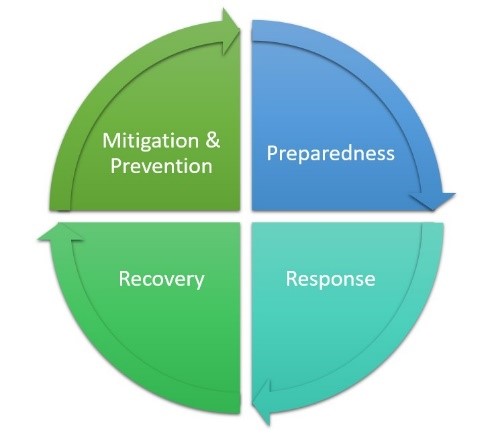The term “hazard mitigation” describes actions that can help reduce or eliminate long-term risks caused by hazards, or disasters, such as floods, hurricanes, wildfires, landslides, tornadoes, earthquakes, or dam failures. As the costs of disasters continue to rise, governments and citizens must find ways to reduce hazard risks to communities. Efforts made to reduce hazard risks should be compatible with other community goals; safer communities are more attractive to employers as well as residents. As communities plan for new development and improvements to existing infrastructure, mitigation can and should be an important component of the planning effort. While mitigation activities can and should be taken before a disaster occurs, hazard mitigation is essential. Often after disasters, repairs and reconstruction are completed in such a way as to simply restore damaged property to pre-disaster conditions. The implementation of such hazard mitigation actions leads to building stronger, safer and smarter communities that are better able to reduce future injuries and damage.

Hazard Mitigation Breaks the Cycle
When recurrent disasters take place such as riverine flooding, repeated damage and reconstruction can occur. This recurrent reconstruction becomes more expensive as the years go by. Hazard mitigation breaks this expensive cycle of recurrent damage and increasing reconstruction costs by taking a long-term view of rebuilding and recovering from disasters.
Hazard Mitigation Plans
The Washington County Hazard Mitigation Plan is required by state and federal agencies in order for communities in Washington County to be eligible for certain types of non-emergency disaster assistance, including funding for mitigation projects.
A HMP will assist Washington County and its jurisdictions with the following:
- An increased understanding of the natural hazards the County faces.
- Development of more sustainable and resilient communities.
- Eligibility for federal funds for pre-disaster mitigation planning before disaster strikes.
- Potential financial savings to residents, including flood insurance premium reductions.
- Reduced long-term impacts and damages to human health and structures, and reduced repair costs.
What Are the Benefits?
There are numerous benefits to participating in the HMP, including:
- Awareness of risk and vulnerabilities
- Identification of implementable strategies and funding sources
- Reduction of hazard impacts (save lives, property, and the local economy)
- Creates partnerships and develops comprehensive approaches that enhance project grant funding opportunities
- Pooling of resources and reducing their level of effort while avoiding duplication of effort
- Creation of more resilient communities – bounce back from disasters faster!
What Types of Mitigation Techniques Can Be Employed?
Hazard mitigation actions are commonly broken into four different categories:
- Local Plans and Regulations (LPR) – These actions include government authorities, policies or codes that influence the way land and buildings are being developed and built.
- Structure and Infrastructure Project (SIP) – These actions involve modifying existing structures and infrastructure to protect them from a hazard or remove them from a hazard area. This could apply to public or private structures as well as critical facilities and infrastructure. This type of action also involves projects to construct manmade structures to reduce the impact of hazards.
- Natural Systems Protection (NSP) – These are actions that minimize damage and losses, and also preserve or restore the functions of natural systems.
- Education and Awareness Programs (EAP) – These are actions to inform and educate citizens, elected officials, and property owners about hazards and potential ways to mitigate them.
Common mitigation actions that are taken include:
- Enforcement of building codes, floodplain management codes, and environmental regulations
- Public safety measures such as continual maintenance of roadways, culverts, and dams
- Acquisition or relocation of structures, such as purchasing buildings located in a floodplain
- Acquisition of hazard prone lands in their undeveloped state to ensure they remain so
- Retrofitting structures and design of new construction such as elevating a home or building
- Protecting critical facilities and infrastructure from future hazard events
- Mitigation, disaster recovery, and Continuity of Operations (COOP) planning
- Development and distribution of outreach materials related to hazard mitigation
- Deployment of warning systems
- Drainage system upgrades
